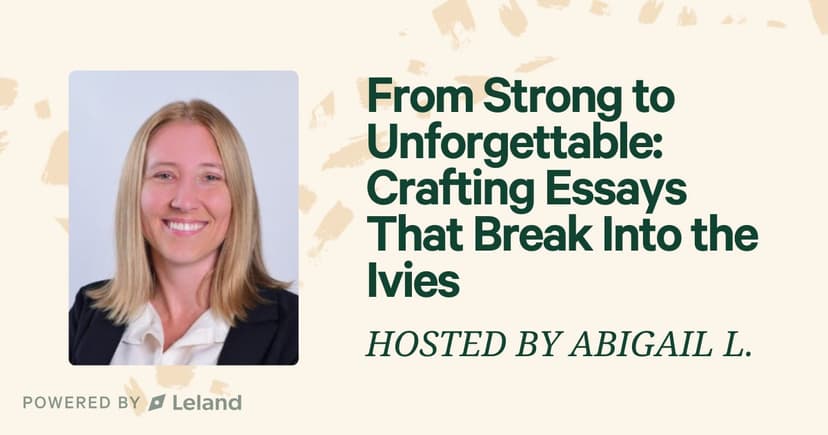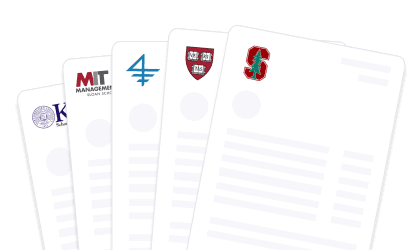
Join a free event
Learn from top coaches and industry experts in live, interactive sessions you can join for free.
Table of Contents
College admissions officers read thousands of college essays each year. Your college application essay is one of the only parts of the application process where you control the story. A strong personal essay can help you stand out, especially when your test scores or extracurricular activities are similar to other students. In this guide, we’ll walk you through how to write great college essays using a simple step-by-step approach. This includes how to choose strong college essay topics, how to outline your essay, and how to revise your writing into a strong final draft. We’ll also include real examples, writing tips, and key takeaways based on what admissions committees actually look for.
Why College Essays Matter More Than Ever
The role of college essays in admissions has changed. With many schools, including Harvard, adopting test-blind or test-optional policies through 2026, your college application essay now carries more weight. When college admissions officers are reviewing thousands of applications from high school students with similar test scores, GPAs, and extracurricular activities, the college essay often becomes the deciding factor. The college application essay is one of the few places where admissions committees get to hear directly from you. Not your transcript. Not your resume. Just your voice.
The Common App recommends keeping essays to about 650 words. That means you have roughly one page to make your story stand out and show why you belong on campus.
What College Admissions Officers Are Really Looking For
Admissions officers review thousands of applications each year, many from students with similar GPAs, test scores, and extracurricular activities. When the numbers are nearly identical, the college application essay becomes the deciding factor, not just because it shows writing skill, but because it reveals the student behind the resume. The personal essay is the only part of the application written entirely in your voice. It’s not your transcript. It’s not your teacher’s recommendation. It’s you. And that matters more than ever.
The Power of Your Personal Statement
Your personal statement helps admissions officers assess things that are impossible to measure with numbers:
- How self-aware are you
- How do you make sense of your experiences
- How clearly and effectively you communicate
- What kind of presence do you bring to the classroom and campus
In a landscape where test-optional and test-blind policies are becoming the norm, the essay is often the best evidence that you’re ready for college-level work, not just academically, but socially and intellectually. This isn’t just about writing a research paper or following grammar rules. It's about making meaning from your past experiences, expressing values clearly, and showing how you think through challenges and ideas
The 3 Questions Admissions Officers Must Answer
| Question | What They’re Really Looking For |
|---|---|
| 1. Who is this student? | They want a real sense of your identity, your values, and your mindset. Not just labels like “hardworking” or “driven,” but proof. They look for students who are self-reflective, authentic, and thoughtful. |
| 2. Will this student contribute to the campus community? | Admissions teams are building a class. They need people who add depth to the community, not just academically, but in clubs, discussions, group projects, and dorm life. They want to see how you relate to others, what you care about, and what kind of voice you’ll bring to campus. |
| 3. Can this student write at a college level? | Your essay needs to show that you can organize ideas, express yourself clearly, and revise thoughtfully. Strong essay writing is concise, structured, and personal, not flowery or generic. Admissions readers don’t just skim; they evaluate writing the way a professor would. |
What that looks like in practice:
- If you describe a moment of failure, they’re asking: Does this student show maturity and insight?
- If you write about a community service experience, they’re asking: Did they grow? Did they take action? Was this meaningful, or just a résumé item?
- If you write about public speaking, they’re asking: What did it reveal about your identity, and how did you change?
The best essays answer these questions without needing to say them out loud. You don’t need to write, “This taught me leadership.” Instead, tell the story and let the meaning come through your words.
Expert Tip: College admissions officers aren’t looking for perfect students. They’re looking for interesting, teachable people who will learn from others and contribute meaningfully. An essay that honestly shows growth, thoughtfulness, or even vulnerability can stand out more than one packed with polished accomplishments.
Choose the Right Essay Topic
Why the Right Topic Makes All the Difference
Your college application essay is not the place to repeat your résumé or show off an award. A common mistake high school students make is choosing a topic that sounds impressive but reveals very little about who they are.
Admissions officers aren’t looking for perfect. They’re looking for authentic. That means your college essay shouldn’t be about your older brother, teacher, or a family member, unless the focus is how that relationship shaped you. Even your most ordinary past experiences can lead to exceptional essays when you reflect deeply and stay honest.
The most effective essay topics focus on something genuinely important to you, not something chosen just to impress the reader. If it helped shape your values, thinking, or future aspirations, it’s worth considering.
How to Find a Topic That Works
If you’re not sure what to write about, that’s normal. Most students don’t have a life-changing story, but they do have personal insights that matter. The key is finding the right moment or idea that lets your authentic voice come through. Here are three structured brainstorming methods that help students discover strong college essay topics:
Values Exercise
Start by listing out your core values. Think beyond “honesty” or “hard work”, get specific. Then think about times in your life when you acted on those values. A moment when you stood up for someone. A time you failed and responded in a way you’re proud of. These moments often lead to compelling personal essays.
Five Objects Exercise
Write down five items that mean something to you. These don’t need to be big or symbolic; your backpack, a kitchen tool, or a sketchbook can all work. For each object, write about what memory or meaning it carries. This method helps uncover stories you might not realize are worth telling.
Past Experiences Reflection
Think about events, big or small, that changed how you view life, school, or yourself. Maybe it was a difficult team project, a moment during community service, or a conversation with a younger sister that stuck with you. Focus on how that experience changed your perspective or helped shape your goals.
Which Essay Structure Should You Use?
Narrative Structure: One Clear Story
The narrative structure follows a single story from beginning to end. You introduce the situation, show how it unfolded, and explain how it changed you. This format works well for stories where you overcame a challenge, made a key decision, or experienced clear personal growth. The structure helps readers follow your writing process and understand your mindset.
If you’re writing about something like a public speaking event that shaped your confidence or a shift in how you viewed extracurricular activities, the narrative format keeps things focused.
Montage Structure: Multiple Moments, One Theme
In contrast, the montage structure groups several short scenes under a unifying theme. Each paragraph or mini-scene focuses on a different part of your life, all tied together by a shared idea.
Montage works well if you want to highlight variety, like how your volunteer work, research paper, and time with your family member all reflect your passion for learning or curiosity. It’s flexible and good for students with broad interests or non-linear stories.
Picking the Structure That Fits Your Story
Both formats can lead to great essays. What matters is how clearly your personality and thinking come through.
- If your topic centers on one turning point, go with a narrative.
- If you want to show a pattern across time or multiple examples, try a montage.
The Essay Writing Process: Step-by-Step
Writing a college essay takes more than one session and more than one draft. If you want your application essay to stand out to college admissions officers, it helps to follow a clear, focused writing process. Here’s how to move from a blank page to a strong, final draft, step by step.
Step 1: Brainstorming
Brainstorming is the first and most important step in writing your college essay. This is the time to gather all your ideas and think about what story you want to tell. Start by reflecting on your life, thinking about the experiences that shaped you and what you are most interested in. Concentrate on what’s important, like challenges you’ve overcome or things that make you unique. Use examples from your school life or personal experiences to help make your story stand out. The point of brainstorming is to discover what will show your perspective and strengths. Don’t worry if you don’t have everything figured out at first. You just have to stay open and let the ideas flow, so you can craft a story that will capture the reader’s attention and show who you are.
Read: College Essay Topic Brainstorming Worksheet + Ideas That Worked
Step 2: Start To Write With Your First Draft
The best time to start your college essay is before senior year gets too busy, ideally during the summer. The key here is not to aim for perfection, but to simply get something written. Just start writing. Your first draft doesn’t have to be great. It just needs to be done. The goal is to get your ideas on paper, even if they’re rough. Don't worry about making it perfect at this stage. Once you have a draft, you can revise and improve it later. Remember, done is better than perfect.
As you write, try to avoid general phrases like “I learned the value of hard work.” Instead, begin with something that shows who you are. Here are a few college essay tips for a strong opening:
- Ask a question that leads into your story
- Describe a specific moment that changed your thinking
- Make a clear, bold statement that invites the reader in
Note: Once you’ve started, keep the momentum going. Don’t stop to edit. Just write your way through a full first draft, even if it’s rough.
Read: How to Craft the Perfect "Why Do You Want to Go to College" Essay
Step 3: Edit (Again and Again)
No one writes exceptional essays on the first try. Most students go through multiple drafts, refining both content and structure over time.
When reviewing your draft, ask yourself:
- Are you repeating information already in your college application?
- Are there general phrases that could be replaced with concrete actions or examples?
- Does each paragraph build on the last and guide the reader through your thinking?
Note: Each revision should make your personal statement clearer and more focused. Cut what doesn’t add value. Replace vague ideas with real stories. Tighten the structure so your application essay feels complete and well-paced.
Step 4: Ask for Feedback Without Losing Your Voice
Once you’ve revised your draft, ask someone you trust to read it. The best readers are people who know you but won’t rewrite the essay for you. This could be a teacher, mentor, or even a younger sister. Ask them questions like:
- What do you remember most?
- What does this essay say about me?
- Was there anything unclear or confusing?
Expert Tip: What matters most is keeping your authentic voice. It’s easy to let others reshape your essay to what they think sounds good. But college admissions officers want to hear from you, not a committee. Use feedback to sharpen your essay, not rewrite it.
Read: 4 Tips to Elevate Your College Essay
Step 5: Read Your Essay Aloud
Reading your essay aloud helps you hear what works and what doesn’t. It’s one of the fastest ways to catch awkward phrasing or sentences that don’t flow.
You’ll also notice places where you didn’t provide enough context or where your tone doesn’t sound like you. If your engaging writing starts to sound like a school research paper, go back and revise with your authentic voice in mind.
Step 6: Finalize and Prepare to Submit
Your final draft should be polished, specific, and true to who you are. Before you submit your college application essay, check the following:
- Is your word count within the limit? (The Common App cap is 650 words.)
- Have you proofread for grammar, punctuation, and spelling?
- Is the formatting clean and readable? Use a standard font and simple layout.
Expert Tip: Give yourself time to make final edits and read through it again. Rushing the last step increases the risk of errors. A strong essay can set you apart from other students with similar test scores, extracurricular activities, or grades. Treat the writing process seriously, and don’t wait until the last week to finish it.
Read: Pro Tips for Writing Successful College Application Essays
How To Make Your Essay Stand Out
Make It About You
To make your essay memorable, connect it to your life and your ideas. Think about what you care about most. It can be your passions, your values, or your goals. Show your growth, what you’ve learned, and how your experiences have influenced the person you are today. Then show how these interests could help you contribute to the school community. The important thing is to communicate your point of view and your unique perspective, so the reader can understand not just what you’ve done, but why it matters to you and how it will guide your future. This personal connection is what makes your essay stand out.
Let Your Story Do the Talking
Admissions officers want to discover who you are through your story, not just through statements. Instead of simply saying, “I care about community service,” describe one real moment when you helped someone or learned something meaningful. Maybe you helped organize a local fundraiser or tutored a younger student, and it changed how you think about helping others. Using examples from your life lets your ideas and personality come through naturally. This approach also helps your words feel real and gives the reader a better sense of your perspective and the kind of person you are.
Tell a Common Story in a Unique Way
It’s okay if your topic is something many students write about, like public speaking, volunteer work, or moving to a new school. What matters is how you tell the story. Share how that experience affected your life or helped you discover something important about yourself. Even common topics can stand out if they highlight your personal growth, your ideas, and what makes your story different. Make your essay about you, not just the activity.
Common College Essay Mistakes to Avoid
Even strong students can make mistakes that keep their essays from standing out. Here are the most common pitfalls and how to avoid them:
1. Over-Polishing the Essay
When you spend too much time editing, your essay can start to sound stiff or unnatural. Admissions officers want to hear your voice, not the voice of a teacher, parent, or professional editor. For example, if you replace simple words with fancy vocabulary just to impress, it can feel forced. Keep your tone natural and personal.
2. Repeating Your Resume
Your essay should add something new, not repeat the activities, awards, or test scores already listed on your application. For instance, instead of writing, “I am the captain of the soccer team,” share what you learned or how you grew from that experience, such as developing leadership skills or learning to work through conflict with teammates. The essay is your chance to show depth, values, and perspective, not just a list of accomplishments.
3. Ignoring the Prompt
Many students get excited about their ideas and end up writing about something unrelated to the prompt. If the question asks about a challenge you’ve faced, stick to that challenge and what it taught you. For example, if the essay prompt asks, “Describe a time you failed and how you responded,” don’t write about a summer trip or a favorite hobby. Stay focused on the lesson and your growth from that experience. Strong essays always answer the question clearly and directly.
Final Submission Checklist: Questions to Ask Yourself Before Submitting Your Essay
- Did I answer the prompt?
- Have I followed all of the requirements (e.g., word count)?
- Is my first sentence compelling?
- Does it grab the reader’s attention and set the tone for the rest of the essay?
- Have I included content that can be found elsewhere in the application?
- Am I presenting new information that adds value?
- Does this sound and feel like me? Have I kept my authentic voice throughout the essay?
- Could only I have written this essay?
- Does it reflect my unique perspective, experiences, and growth?
Read: How to End a College Essay (With Examples)
5 Expert Tips for Writing a Standout College Essay
1. Choosing Your Topic: No Wrong Answers
When it comes to your college application essay, the topic doesn’t have to be groundbreaking. It just needs to be meaningful to you. The biggest misconception is that the subject you choose will determine your success, but that's not true. What matters most is how you write about it. If you pick something you’re passionate about, you’ll naturally connect it to your identity. Show your personal growth, values, and the way this topic reflects who you are. Whether you write about something as simple as making dumplings or a life-changing moment, it’s the ideas you draw from that make the essay stand out. Just make sure your topic reinforces what’s already highlighted in your application.
Main takeaway: Focus on how you write about your topic, not just what it is. Your essay should reflect your unique identity and growth.
2. The Hook: Use it, but Get to the Point
A strong hook grabs the reader's attention right away, but remember it should be brief and to the point. Avoid going overboard with a long, dramatic introduction. Instead, aim for something intriguing yet simple. A good hook should also set up what’s to come, connecting quickly to the main point of your essay. Don’t waste valuable space with overly complex or cheesy openings; keep it clear and relatable. Admissions committees read hundreds of essays, so make sure yours stands out right from the first line.
Main takeaway: Keep your hook intriguing but short. Make it clear and connected to your main message right from the start.
3. Tone: Strike the Right Balance in Terms of Formality
Your essay should sound authentic and personable. That means avoiding both overly formal language and slang. Admissions officers want to read an essay that shows your personality, but they also need to know you can communicate clearly and respectfully. A good rule of thumb is to write as if you're talking to an adult family friend. Avoid using curse words or too much slang, but don’t make your language so stiff that it sounds like a textbook. Keep your tone friendly and relatable while still sounding thoughtful and mature. Striking this balance will help your writing feel both engaging and professional.
Main takeaway: Keep your tone natural and balanced, personal but respectful, formal but friendly.
4. Technical Writing Tip: Master the Syntax
While the content of your essay is crucial, your writing mechanics matter too. Admissions committees pay attention to how well your essay flows, so mastering syntax (sentence structure) is a must. Varying your sentence lengths can keep your writing engaging and help convey your ideas clearly. Short sentences can create impact, while longer ones allow you to expand on important points. Think of your essay as a conversation: it should flow smoothly and keep the reader interested. A few well-placed longer sentences mixed with concise ones can make your writing more dynamic, and it shows you’ve put effort into making it engaging.
Main takeaway: Keep your sentences varied. It can be short and impactful, with occasional longer ones to elaborate on important points.
5. The Conclusion: Make Sure it Ties
The conclusion of your essay should leave a lasting impression, but it doesn’t need to repeat what you've already said. A good conclusion ties everything together, reinforcing your main point without restating it word-for-word. Think of your conclusion as a final opportunity to reflect on your growth and to showcase how the story you told relates to your future aspirations. Rather than rushing it, take time to make sure your conclusion continues the tone and message you’ve established. If you’ve followed the right steps, the conclusion should feel like a natural wrap-up.
Work With an Expert to Strengthen Your Essay
Refine your college essay with a Leland Coach. Want help with brainstorming, essay writing, or your final draft? Leland coaches can guide you through every part of the application process. You’ll get: Help finding a topic, feedback on your first draft, structure, and support from people who’ve worked with college admissions officers. Work with a college application coach here!
Read these next:
- Early Decision for College: What to Know in 2025
- What Really Matters When Preparing for College
- The 10 Most Common College Interview Questions (And How to Answer Them)
- How to Pick the Best College for You
- The Top 40 College Scholarships
- How to Craft the Perfect "Why Do You Want to Go to College" Essay
FAQs
What do you write for a college essay?
- For your college essay, you want to focus on a personal topic that showcases who you are beyond your grades and test scores. This could be a significant experience, a challenge you’ve overcome, or something that reflects your interests, values, or growth. Admissions committees are interested in discovering your unique perspective and how your experiences have shaped you. For example, if you volunteered during the past summer or participated in a school project, you can write about how those experiences influenced your future goals. Remember, the goal is to make your essay personal and reflective, providing context about how you’ve grown and what you’ve learned.
How do you start your college essays?
- Starting your college essay can be intimidating, but a great way to begin is with a compelling hook. This could be a personal anecdote, a thought-provoking question, or a powerful statement that draws the reader in. For instance, if you’re writing about a personal experience from high school, start with an example that shows the emotions or lessons you gained from it. Make sure your introduction sets the tone and gives insight into the story you are about to tell. It’s important to engage the reader right away, showing your interest and making them want to read more about your journey.
What are the 5 D's of college essays?
- The "5 D's" of college essays refer to key principles that can help you create a strong, memorable personal essay. These are:
- Dedication – Show how committed you are to your passions or goals.
- Discovery – Share moments of growth and self-discovery.
- Depth – Go beyond surface-level descriptions and provide deeper insights into your experiences.
- Diversity – Highlight what makes you unique and how you bring diverse perspectives.
- Determination – Demonstrate how you’ve overcome challenges and remained focused on your goals.
- These elements make your essay stand out and help you present a more complete picture of who you are.
How do you start your college essay?
- Starting your college essay should be about grabbing the reader’s attention with a strong opening line. You might start by describing a specific moment or asking a thought-provoking question that connects to your larger theme. For instance, if you are writing about a family member who has shaped your values, you might begin by describing an impactful conversation or lesson they taught you. This technique helps the reader get engaged right away and gives them a glimpse of your perspective and how it ties into the rest of your personal essay.
Can ChatGPT write a college essay?
- ChatGPT can certainly help guide you through the college essay writing process by providing suggestions, brainstorming ideas, and even assisting with drafting. However, the most important part of a college essay is that it reflects your voice, ideas, and personal experiences. While ChatGPT can help you structure your essay and offer examples, you need to put in the effort and ensure that your essay authentically represents your journey. Think of ChatGPT as a writing assistant, providing a framework or helping with ideas, but the ultimate content must come from you, showcasing your perspective and how you’ve grown through high school and beyond.
Browse hundreds of expert coaches
Leland coaches have helped thousands of people achieve their goals. A dedicated mentor can make all the difference.


























